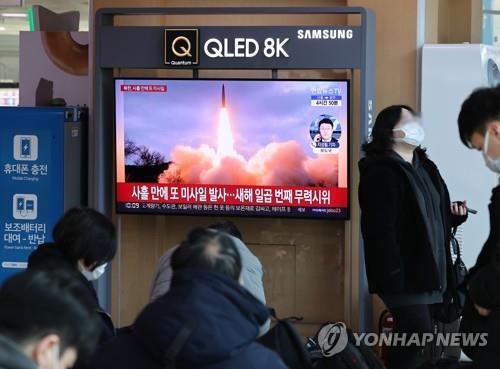- California Assembly OKs highest minimum wage in nation
- S. Korea unveils first graphic cigarette warnings
- US joins with South Korea, Japan in bid to deter North Korea
- LPGA golfer Chun In-gee finally back in action
- S. Korea won’t be top seed in final World Cup qualification round
- US men’s soccer misses 2nd straight Olympics
- US back on track in qualifying with 4-0 win over Guatemala
- High-intensity workout injuries spawn cottage industry
- CDC expands range of Zika mosquitoes into parts of Northeast
- Who knew? ‘The Walking Dead’ is helping families connect
N. Korea seen preparing for another imminent ICBM system test: sources
South Korea and the United States have detected signs that North Korea is preparing to conduct another intercontinental ballistic missile (ICBM) system test as early as this week, informed sources here said Monday.
Such indications emerged after Seoul and Washington accused Pyongyang on Friday of having tested a new ICBM system on Feb. 27 and March 5 ahead of a full-range ICBM test.
The North has characterized the two launches as “reconnaissance satellite” development tests. South Korean and U.S. officials believe they involved the Hwasong-17 ICBM unveiled during a military parade in October 2020.
“Though we can’t say definitively when a missile will be launched, we have been keeping close tabs on the possibility,” a government source told Yonhap News Agency on condition of anonymity.
Asked to comment on the possibility of another North Korean missile test, an official at Seoul’s Joint Chiefs of Staff refused to make “prejudgment” but stressed South Korea’s “robust” readiness posture.
Weather conditions and other variables are expected to affect the timing of the North’s possible launch.
Should the North press ahead with a new launch, the North could fire a missile from a transporter erector launcher (TEL) at the Sunan airfield, the site of the two previous tests, observers said.
In the earlier tests, the North fired the missile at a high angle from the airfield and engineered it to travel on a trajectory of a medium-range ballistic missile.
The missile fired on Feb. 27 flew about 300 kilometers at a top altitude of 620 km, while the one fired on March 5 traveled around 270 km at a top altitude of 560 km.
Concerns have persisted that the North could engage in more provocative acts as it made a veiled threat in January to lift its yearslong self-imposed moratorium on nuclear and ICBM tests.
Other than signs of the North’s preparations for a missile launch, the country has also appeared to be working to restore part of its purportedly demolished Punggye-ri nuclear test site and remove South Korean-built facilities at the Mount Kumgang resort, sources have said.
Commenting on these moves, Lee Jong-joo, spokesperson for Seoul’s unification ministry, said the government has been preparing for “all possibilities” based on cooperation with the U.S.
“We urge the North again to immediately stop acts that run counter to peace and stability on the Korean Peninsula and are of no help to the development of inter-Korean relations,” she told a regular press briefing.
Lee also called on the North to return to a “path of dialogue and cooperation.”

A news report on North Korea’s launch of an intermediate-range ballistic missile airs on a television at Seoul Station on Jan. 30, 2022. (Yonhap)












